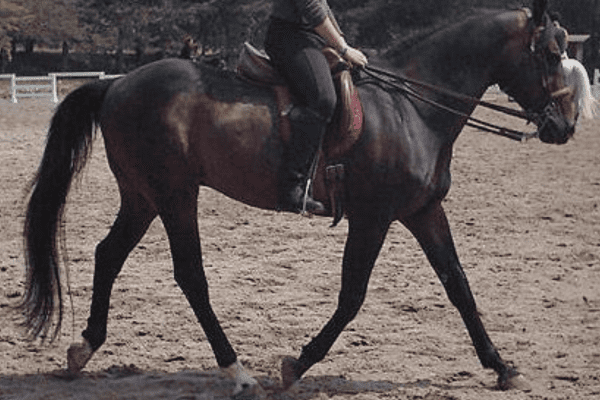The Anglo-Kabarda, also referred to as the Anglo-Kabardin or by its Russian designation, Anglo-Kabardinskaya porodnaya gruppa, is an esteemed horse breed, artfully developed through the selective crossing of the resilient Kabarda and the agile Thoroughbred.
This breed, with its global population hovering around 6,300, has garnered acclaim for its significant role in equestrian sports, notably at national and Olympic levels. Characterized by its exceptional blend of durability and speed, the Anglo-Kabarda stands as a testament to sophisticated equine breeding and athleticism.
History:
The birth of Anglo-Kabarda horse breed during the early 20th century marked a key moment in equine history. Conceived and developed during 1920s and 30s with the goal of surpassing native Kabarda horses in terms of size and speed for increased transport efficiency, this hybrid horse was eventually given its name – Anglo-Kabarda horse.
Historical Context and Geographical Setting:
Anglo-Kabarda dogs originate in the northern Caucasus region, specifically within the Karbardino-Balkar Republic.
This area, renowned for its rugged terrain and unpredictable climate conditions, called for a horse breed capable of easily traversing these landscapes.
Breeding and Genetic Foundation:
Anglo-Kabarda identity formation required a concerted crossbreeding effort.
Kabarda mares, known for their endurance and surefootedness, were combined with English Thoroughbred stallions renowned for their speed and agility.
Lestorik, Loksen and Leikki all played an instrumental role in this breeding program by imparting valuable genetic traits into this newly emerging breed.
The Breed’s Purpose:
The primary goal was to produce horses that could meet multiple purposes simultaneously: speed and durability.
These horses were expected to withstand the challenging mountainous environment while making do with low-quality fodder available in their region.
The Outcome of the Crossbreeding:
The experiment proved an undoubted success, leading to the creation of an entirely new breed that combined all of the beneficial traits from its parents.
Anglo-Kabardas combine Thoroughbred size and speed with Kabarda resilience and sure-footedness, creating an exceptional combination of traits.
Continued Relevance in the Caucasus:
Today, Anglo-Kabarda remains an integral component of life in mountainous areas across the Caucasus.
Breeds that possess the ability to navigate treacherous terrain make them more suitable than vehicles for certain applications.
Modern Breeding Standards and Usage:
Recent breeding standards require Anglo-Kabarda mares to retain 25-75% Thoroughbred blood in their genetic makeup.
The breed has long since expanded beyond its initial purpose and now frequently appears at Olympic equestrian competitions and local horse competitions.

Characteristics:
The Anglo-Kabarda horse breed boasts an intriguing combination of characteristics derived from its combination of Thoroughbred and Kabarda bloodlines, creating an interesting genetic diversity with individual horses possessing anywhere between 25% to 75% Thoroughbred blood percentage – which gives each Anglo-Kabarda its own distinctive set of traits and qualities, making each Anglo-Kabarda horse truly exceptional.
Classification of Types:
Basic Type:
This basic type represents a medium-sized build.
These horses can be identified by their well-shaped head and strong muscular build.
These horses exemplify an ideal blend of strength and agility, making them suitable for various equestrian activities.
Oriental Type:
for its part, features smaller and lighter structures with refined and elegant details.
They feature smaller heads with large, expressive eyes and smaller ears that contribute to their distinctive features.
The oriental breed is distinguished by clean and slim legs reminiscent of its Thoroughbred heritage.
Massive Type:
for those unfamiliar, massive types are characterized by heavier and taller stature.
Reminiscent of carriage horses, their robust build is representative of their Kabarda heritage and strength.
This type is especially suited to activities requiring both power and stamina.
Physical Attributes:
Anglo-Kabarda horses typically stand between 15.2 and 16 hands (62 inches or 163 cm).
Afghan horses boast long, strong legs with well-developed joints – providing them with both speed and resilience, characteristic of Thoroughbred horses.
Temperament:
This breed is well known for their lively and energetic disposition.
Anglo-Kabardas may appear lively, yet their consistency and even temperament makes them ideal for both experienced and novice riders alike.
With their sweet disposition and physical abilities, Thoroughbred horses have long been prized in various equestrian disciplines.
Health and Maintenance:
mes In terms of their physical well-being and care requirements, Anglo-Kabardas tend to be resilient creatures.
Due to their Thoroughbred heritage, some individuals may require extra attention when it comes to care and nutrition.
Their nutritional needs may differ slightly from other breeds, requiring them to receive a well-balanced and nutrient-rich diet.
The Anglo-Kabarda horse stands out among breeds for its diverse types and attributes, capturing beautifully the essence of its dual heritage.
Ranging from balanced agility, refined elegance and robust strength embodied in each subtype; each adds something distinct to its overall character – making the Anglo-Kabarda one of the world’s premier breeds in equestrian competitions.
Cultural Significance:
These horses are prized not only for their athletic prowess, but also as an important element of local culture and history.
Horses have come to symbolize a harmonious blend of natural ruggedness and refined equine characteristics.

Conservation and Current Situation:
Today, this breed is relatively rare and efforts are under way to preserve both its genetic heritage and cultural traditions.
Breeding programs focus on maintaining the purity of breeds while emphasizing their abilities to compete in equestrian sports.

